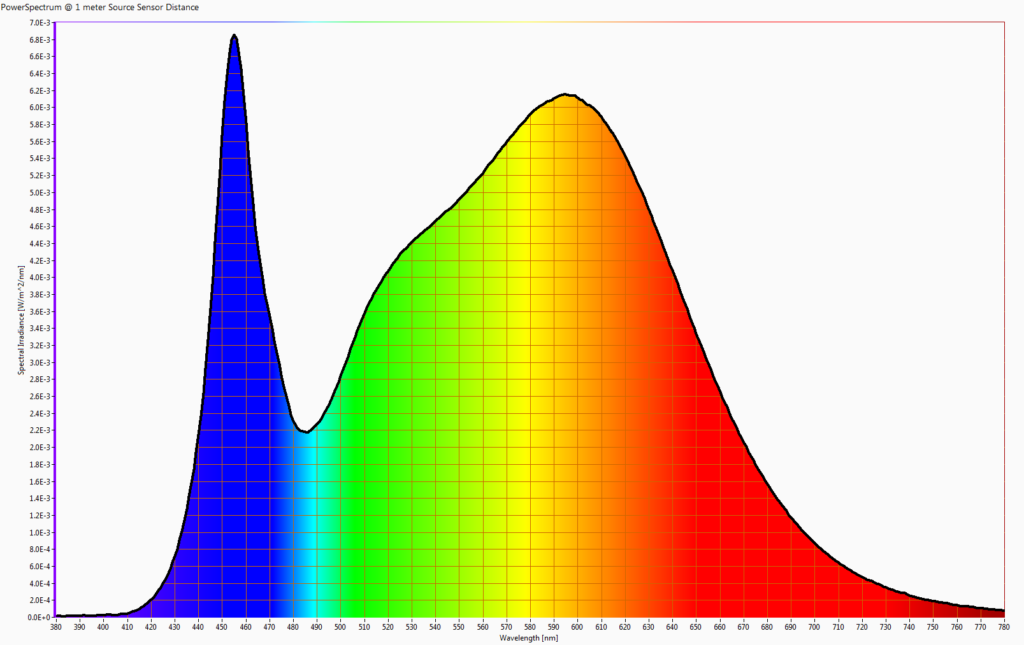Residential
We recommend incandescent light bulbs, not LEDs, because the long term effects of LED visible radiation is lacking rigorous study. Since LEDs do not light a room uniformly, LED light bulbs are not a viable choice for indoor illumination. We believe that any LED light bulb that exceeds 2700 Kelvin is dangerous for everyone and the higher the lumens, the higher the danger.
LED bulbs that have an amber color are safer because there is less blue wavelength light. The amber light is also more appropriate for lighting used before sleep. A 300 lumen 2200 Kelvin is much less toxic than a 1600 lumen 5000 Kelvin LED. However, even at 300 lumen and 2200K color temperature, the non-uniform bullet shape is still foreign to human nerves and may be causing sickness.
Flicker is not listed on the light bulb packaging, and therefore there is almost no way to know how your nervous system will react to the subsensory flicker created by the LED electronics.
Figure 1 illustrates approximate Correlated Color Temperature for LED lights. While CCT is not actually a legitimate way to measure the spectral power distribution of LED light, the industry uses this CCT value. However, we must be very careful with understanding the true nature of what this means. Note that all the lamps are diffused with a lamp shade, which is a must for eye safety. Never use an LED device where the bare diode is visible to your eye.

Figure 2 shows the Spectral Power Distribution for a 4000 Kelvin LED. The large spike of blue wavelength light occurs because the blue wavelength is the true source of the light from the LED. It’s only after passing through the yellow phosphor that additional colors are created, thus creating a fake white color. But your brain is much too smart for this trick, and will react to this unnatural blue spike followed by the trough in cyan. In addition, the blue wavelength light at 450 nanometers is dangerous for your eye and must be avoided. Blue wavelength light also controls your circadian rhythms and must be avoided in the evening and night.
The result is that the higher the CCT you select, the more risk to your health. 2700K is generally considered the maximum limit you should select, but even then, there are not enough to studies to know the long term effects of LED light beams. Also, the higher the lumens (amount of light) you select, the more risk to your health.
Figure 3 shows the nutrition labels for 2000K, 300 lumens, 2700K at 820 lumens, 3000K at 160 lumens, 4000K at 700 lumens and 5000K at 2600 lumens. The Correlated Color Temperature essentially tells you how much blue wavelength is emitted by the LED, whereas the lumens tells you the amount of light. In these examples, the safest lights will be either the 2000K at 300 lumens or the 3000K at 160 lumens. The 2700K, 820 lumen light will be a comfortably bright light (with lamp shade) and may be ok for some people, but cause migraines or other neurological reactions for others. The 4000K, 700 lumen will have too much blue to be safe for anyone. The 5000K, 2600 lumen is truly dangerous.
No matter what Correlated Color Temperature or total lumens you choose, the spatial shape of the light will still be a non-uniform bullet shape that is not appropriate for illumination of a room. The quality of the light will always be low, and the higher the CCT and the higher the lumens, the more likely the light is to interfere with your nerves and cause reactions anywhere from mild annoyance to agitation to headache to migraine to seizure.
Street Lighting
LEDs are completely inappropriate for illuminating large volumes of space. LEDs emit a non-uniform shape, with an extremely high light density in the middle. LEDs must never be used in streetlights.
High Pressure Sodium has a luminous efficacy as high as 150 lumens per watt, whereas LEDs are only reaching 120 lumens per watt. Therefore, even if we ignored the bullet shape of LED light, there still would be no reason to switch to LED since LED is not more energy efficient than HPS.
Before a city installs any streetlights, a city must take baseline readings for light pollution. Removing all streetlights would be the best solution because it will result in large energy savings, reduced carbon footprint, and likely reduced crime and increased safety. If, after establishing the baseline light pollution readings, city officials still decide to install streetlights, then we recommend HPS or Low Pressure Sodium. A typical HPS installation will use 100 watt, 150 watt and even 200 watt lights, which is excessive. We recommend 50 watt HPS with proper shielding and diffusion.
The natural night is a critical resource for human health, so the goal should be removal of artificial light. We can assure you that removal of streetlights will not reduce safety or increase crime. The research supports our arguments.

